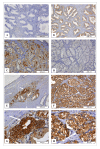A comparative study of recombinant and native frutalin binding to human prostate tissues
- PMID: 19740412
- PMCID: PMC2754448
- DOI: 10.1186/1472-6750-9-78
A comparative study of recombinant and native frutalin binding to human prostate tissues
Abstract
Background: Numerous studies indicate that cancer cells present an aberrant glycosylation pattern that can be detected by lectin histochemistry. Lectins have shown the ability to recognise these modifications in several carcinomas, namely in the prostate carcinoma, one of the most lethal diseases in man. Thus, the aim of this work was to investigate if the alpha-D-galactose-binding plant lectin frutalin is able to detect such changes in the referred carcinoma. Frutalin was obtained from different sources namely, its natural source (plant origin) and a recombinant source (Pichia expression system). Finally, the results obtained with the two lectins were compared and their potential use as prostate tumour biomarkers was discussed.
Results: The binding of recombinant and native frutalin to specific glycoconjugates expressed in human prostate tissues was assessed by using an immuhistochemical technique. A total of 20 cases of prostate carcinoma and 25 cases of benign prostate hyperplasia were studied. Lectins bound directly to the tissues and anti-frutalin polyclonal antibody was used as the bridge to react with the complex biotinilated anti-rabbit IgG plus streptavidin-conjugated peroxidase. DAB was used as visual indicator to specifically localise the binding of the lectins to the tissues. Both lectins bound to the cells cytoplasm of the prostate carcinoma glands. The binding intensity of native frutalin was stronger in the neoplasic cells than in hyperplasic cells; however no significant statistical correlation could be found (P = 0.051). On the other hand, recombinant frutalin bound exclusively to the neoplasic cells and a significant positive statistical correlation was obtained (P < 0.00001). However, recombinant frutalin did not recognise all malignant prostate cases and, when positive, the binding to those tissues was heterogeneous.
Conclusion: Native and recombinant frutalin yielded different binding responses in the prostate tissues due to their differences in carbohydrate-binding affinities. Also, this study shows that both lectins may be used as histochemical biomarkers for the prostate cancer. Moreover, the successful use of a recombinant lectin in immunohistochemical studies of prostate cancer was for the first time demonstrated, highlighting the advantages of using recombinant systems in the preparation of pure lectin samples for diagnostic purpose.
Figures

Similar articles
-
Cytotoxic effects of native and recombinant frutalin, a plant galactose-binding lectin, on HeLa cervical cancer cells.J Biomed Biotechnol. 2011;2011:568932. doi: 10.1155/2011/568932. Epub 2011 Nov 1. J Biomed Biotechnol. 2011. PMID: 22131813 Free PMC article.
-
Expression of frutalin, an alpha-D-galactose-binding jacalin-related lectin, in the yeast Pichia pastoris.Protein Expr Purif. 2008 Aug;60(2):188-93. doi: 10.1016/j.pep.2008.04.008. Epub 2008 May 1. Protein Expr Purif. 2008. PMID: 18534865
-
Recombinant production of plant lectins in microbial systems for biomedical application - the frutalin case study.Front Plant Sci. 2014 Aug 8;5:390. doi: 10.3389/fpls.2014.00390. eCollection 2014. Front Plant Sci. 2014. PMID: 25152749 Free PMC article. Review.
-
cDNA cloning and functional expression of the alpha-D-galactose-binding lectin frutalin in Escherichia coli.Mol Biotechnol. 2009 Nov;43(3):212-20. doi: 10.1007/s12033-009-9191-7. Epub 2009 Jun 12. Mol Biotechnol. 2009. PMID: 19521795
-
Lectins applied to diagnosis and treatment of prostate cancer and benign hyperplasia: A review.Int J Biol Macromol. 2021 Nov 1;190:543-553. doi: 10.1016/j.ijbiomac.2021.09.011. Epub 2021 Sep 9. Int J Biol Macromol. 2021. PMID: 34508719 Review.
Cited by
-
Lectins, Interconnecting Proteins with Biotechnological/Pharmacological and Therapeutic Applications.Evid Based Complement Alternat Med. 2017;2017:1594074. doi: 10.1155/2017/1594074. Epub 2017 Mar 7. Evid Based Complement Alternat Med. 2017. PMID: 28367220 Free PMC article. Review.
-
Fusion tags for protein solubility, purification and immunogenicity in Escherichia coli: the novel Fh8 system.Front Microbiol. 2014 Feb 19;5:63. doi: 10.3389/fmicb.2014.00063. eCollection 2014. Front Microbiol. 2014. PMID: 24600443 Free PMC article. Review.
-
Cytotoxicity of Frutalin on Distinct Cancer Cells Is Independent of Its Glycosylation.Molecules. 2021 Aug 4;26(16):4712. doi: 10.3390/molecules26164712. Molecules. 2021. PMID: 34443300 Free PMC article.
-
Crystallization and preliminary X-ray diffraction studies of frutalin, an α-D-galactose-specific lectin from Artocarpus incisa seeds.Acta Crystallogr F Struct Biol Commun. 2015 Oct;71(Pt 10):1282-5. doi: 10.1107/S2053230X15015186. Epub 2015 Sep 23. Acta Crystallogr F Struct Biol Commun. 2015. PMID: 26457519 Free PMC article.
-
Cytotoxic effects of native and recombinant frutalin, a plant galactose-binding lectin, on HeLa cervical cancer cells.J Biomed Biotechnol. 2011;2011:568932. doi: 10.1155/2011/568932. Epub 2011 Nov 1. J Biomed Biotechnol. 2011. PMID: 22131813 Free PMC article.
References
-
- Pienta KJ, Esper PS. Risk factors for prostate cancer. Ann Intern Med. 1993;118:793–803. - PubMed
-
- Rodriguez C, Tatham LM, Thun MJ, Calle EE, Heath CW., Jr Smoking and fatal prostate cancer in a large cohort of adult men. Am J Epidemiol. 1997;145:466–475. - PubMed
-
- Kolonel LN. Fat, meat, and prostate cancer. Epidemiol Rev. 2001;23:72–81. - PubMed
Publication types
MeSH terms
Substances
LinkOut - more resources
Full Text Sources
Medical

